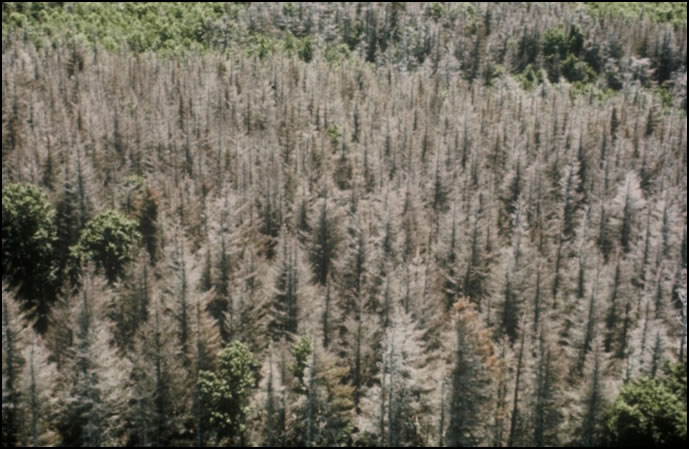The (eastern) spruce budworm (Choristoneura fumiferana) is a moth native to North America.
The eastern spruce budworm (top: adult moth; bottom: caterpillar).
Spruce budworm feeds mainly on balsam fir and white spruce, and to a lesser extent on red spruce and black spruce. Trees usually die after four or five consecutive years of severe defoliation.
Quick facts
- Outbreak cycles of spruce budworm occur every 30 to 40 years.
- During an outbreak, tens of millions of hectares of trees can be severely defoliated. An outbreak may last several years.
- The most recent outbreak started in Quebec on the north shore of the St. Lawrence River in 2006, with about 3,000 hectares being defoliated.
- By 2019, over 9.6 million hectares of forest in Quebec has suffered moderate to severe defoliation.
- In western Canada, outbreaks of spruce budworm occur intermittently at the edge of its range in northern boreal forests from Manitoba through the Yukon.
Impacts
The spruce budworm has a significant impact on Canada’s forests.

Aerial view of defoliation caused by the eastern spruce budworm.
- Spruce budworm damage appears in May.
- Evidence of a spruce budworm infestation includes the destruction of buds, abnormal spreading of new twigs, defoliation of current-year shoots and, if an affected branch is disturbed, the presence of large numbers of larvae suspended from strands of silk.
- Defoliation begins at the top of the tree and current-year needles are partially or completely consumed. If large numbers of larvae are present, previous-year needles may also be affected. Spruce budworm larvae also feed on staminate (male) flowers and cones. During epidemics, the larvae may destroy all of the cones.
- Spruce budworm larvae also feed on staminate (male) flowers and cones. During epidemics, the larvae may destroy all of the cones.
- Severely affected tree stands turn a rust colour due to the presence of dried-out needles held together by strands of silk spun by the larvae. In the fall, most dead needles are dispersed by the wind and defoliated stands take on a greyish appearance.
- A single year of defoliation generally has little impact on the tree. However, it does cause weakening of the tree, making it more susceptible to attacks by other insects.
- Cumulative defoliation can cause significant mortality and growth loss in mature spruce-fir forests; resulting in significant losses of important timber and non-timber resources.
CFS scientific research
Research conducted by scientists at the Canadian Forest Service (CFS) has led to many insights into the spruce budworm’s population ecology and management.
- Adult moths mate and lay eggs in clusters of 10-150 on the needles of host trees in July and August.
- Newly hatched larvae spin cocoons in protected areas on the host tree where they spend the winter.
- In the spring, larvae emerge and start feeding on new foliage using the needles to build a silken shelter to protect themselves from predators.
- Defoliation becomes visually noticeable in late June when larvae have completed most of their feeding.
- Budworm moths emerge from pupae in July/August and lay eggs on the foliage to complete their life cycle.
Spruce Budworm Early Intervention Strategy
The Spruce Budworm Early Intervention Strategy (EIS) is a research program investigating a new pest management approach that could avoid a spruce budworm outbreak and the associated socio-economic impacts.
The strategy aims to interrupt or slow the progression of a spruce budworm infestation by targeting "hot spots" or "epicenters" when population density is still low. A suite of integrated research activities and operational insecticide applications validate the program’s scientific foundation, enhance its success for any emerging outbreaks of spruce budworm and protect Canada’s forests.
Working collaboratively to develop solutions
Through the Canadian Forest Service, Natural Resources Canada works in collaboration with provincial governments and other agencies, such as the Société de protection des forêts contre les insectes et maladies and the Healthy Forest Partnership, to develop management tools and tactics to predict and mitigate damage caused by spruce budworm outbreaks.
The EIS is being delivered by Natural Resources Canada, in collaboration with the Healthy Forest Partnership, a research consortium that includes CFS scientists, the four Atlantic Provinces as well as representatives from industry and academia.
Want more information on the eastern spruce budworm?
Contact:
- Atlantic Forestry Centre
- Joe Bowden
- Rob Johns
- Eric Moise
- Marc Rhainds
- Peter Silk
- Michael Stastny
- Laurentian Forestry Centre
- Great Lakes Forestry Centre
- Digging up dirt on the spruce budworm (podcast - 2020)
- Slowing Down the Spruce Budworm (video)
- Research on the spruce budworm (video)
- Spruce Budworm Outbreaks (video)
- CFS spruce budworm research projects